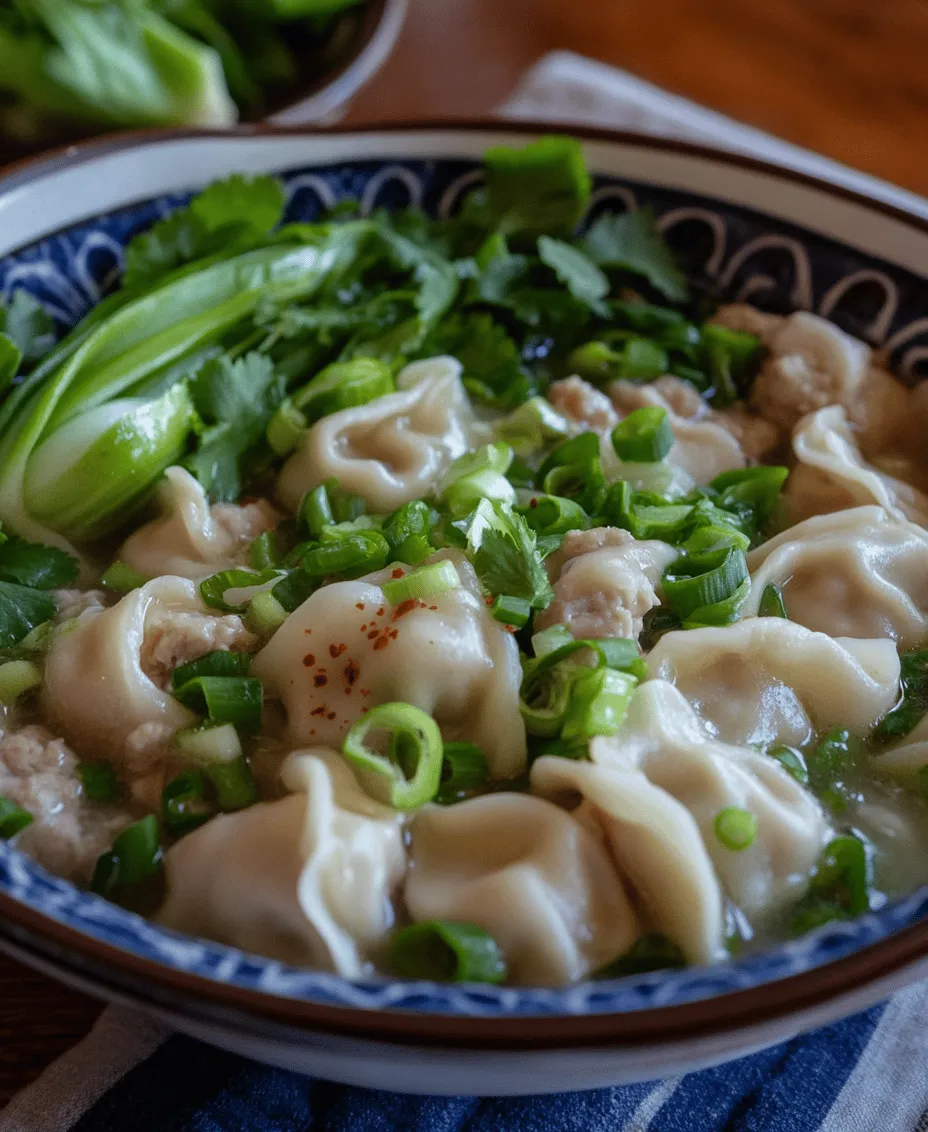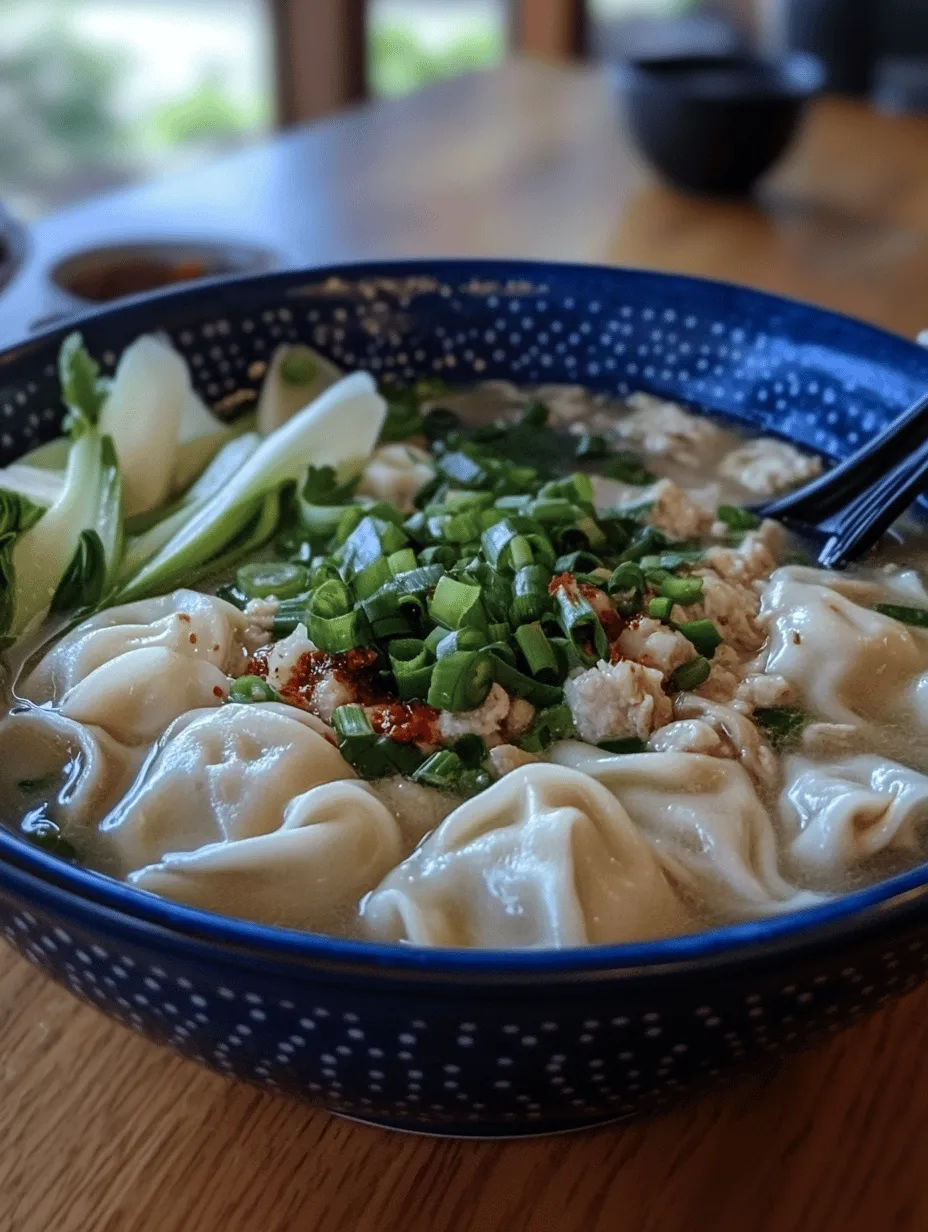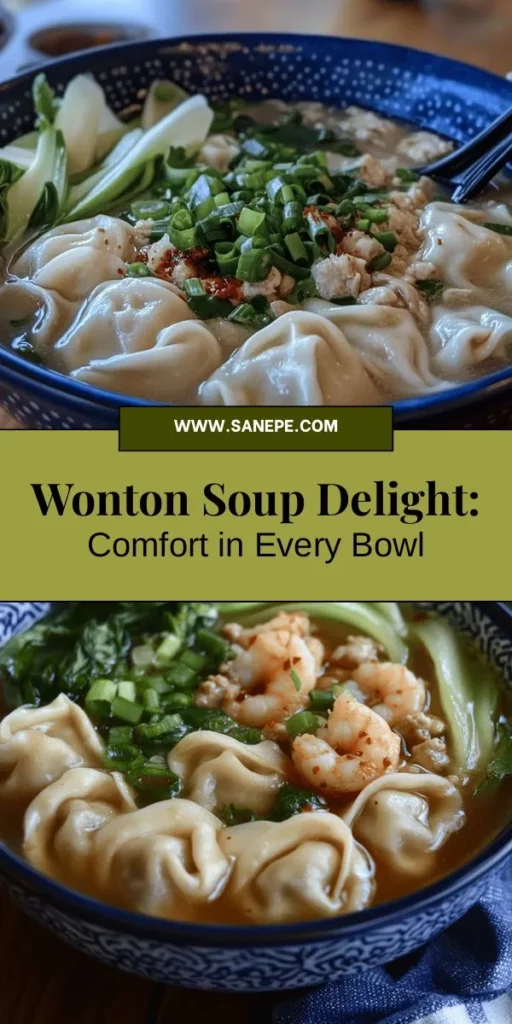Introduction
Wonton soup is more than just a dish; it’s a warm embrace that embodies comfort, tradition, and nostalgia across various cultures. Originating from Chinese cuisine, this soup has found its way into the hearts and homes of many, becoming a beloved staple in Asian dining. With its delicate dumplings filled with savory goodness resting in a fragrant broth, wonton soup is the epitome of comfort food that nourishes both the body and soul.
Today, we introduce you to Wonton Soup Delight, a recipe that elevates this classic dish with a unique combination of flavors and textures, making it a true standout among traditional versions. Imagine tender wontons bursting with a delicious filling, perfectly complemented by a rich, aromatic broth. This recipe not only satisfies your taste buds but also invites you to experience the joy of creating something from scratch, reminding us of the importance of homemade meals in our fast-paced lives.
In this article, we will take you on a journey through the history of wontons, explore their cultural significance, and guide you step-by-step through the preparation of Wonton Soup Delight. Whether you’re looking to warm up on a chilly evening or impress your friends and family with a culinary masterpiece, this recipe is sure to become a cherished addition to your kitchen repertoire.
The Cultural Significance of Wontons
Wontons have a rich history that dates back to ancient China, where they were often associated with special occasions and festivities. Traditionally, these dumplings symbolize wealth and prosperity, as their shape resembles that of gold ingots used in ancient Chinese currency. Families would gather to make and enjoy wontons during important celebrations such as the Lunar New Year, marking the beginning of a new year filled with hope and good fortune.
As Chinese cuisine spread across the globe, different regions adapted the wonton to suit their local tastes, resulting in a variety of wonton soup styles. In Southern China, for instance, wontons are often served in a clear broth with a hint of soy sauce, while in Hong Kong, they may be accompanied by noodles and a richer stock. Meanwhile, in Vietnam, a similar dish known as “hoành thánh” features wontons in a broth infused with aromatic herbs and spices, showcasing the versatility of this beloved dumpling.
Wontons also play a vital role in family traditions. The act of preparing wontons can be a communal activity, where family members gather to fold and seal the dumplings, sharing stories and laughter in the process. This bonding experience reinforces cultural connections and creates lasting memories, making wontons a cherished part of many family gatherings.
Understanding the Ingredients
To create Wonton Soup Delight, it’s essential to understand the key ingredients that contribute to its remarkable flavor and nutritional profile. Each component plays a vital role in crafting not just a meal, but a wholesome experience.
Ground Pork vs. Chicken
The filling of the wontons usually features ground meat, with pork and chicken being the most common choices. Ground pork offers a rich, savory flavor profile that pairs beautifully with the delicate wonton wrappers. Its higher fat content provides moisture, ensuring that each bite is juicy and satisfying. On the other hand, ground chicken is a leaner option, delivering a lighter taste while still maintaining a satisfying texture. Depending on your preference or dietary restrictions, you can choose either option, both of which are packed with protein and essential nutrients.
The Significance of Shrimp
Incorporating shrimp into the wonton filling elevates the dish further. Shrimp brings a subtle sweetness and a unique texture that complements the meat, creating a harmonious blend of flavors. Rich in omega-3 fatty acids, shrimp also contributes to heart health and adds a delightful seafood element that enhances the overall taste of the soup.
The Flavor Enhancers: Green Onions and Ginger
Green onions and ginger are not just garnishes; they are key players in enhancing the flavor of Wonton Soup Delight. Green onions provide a fresh, mild onion flavor that brightens the dish, while ginger offers a warm, spicy kick that adds depth to the broth. Both ingredients are known for their health benefits, including anti-inflammatory properties and the ability to aid digestion, making them perfect companions for a comforting soup.
Wonton Wrappers
Wonton wrappers are essential for encasing the delicious filling. These thin sheets of dough can be found in most grocery stores, but making them from scratch is an option for those looking to elevate their culinary skills. The key to using wonton wrappers effectively lies in ensuring they remain moist while you work with them, preventing them from cracking or drying out. A simple damp cloth can help keep them pliable during the filling and folding process.
Soup Ingredients
The soup base is equally important in creating a delightful wonton soup experience. Chicken broth serves as the foundation, providing a savory depth that enhances the flavors of the wontons. Homemade broth is ideal, as it allows for complete control over the ingredients and seasoning, but store-bought options can also be convenient.
Adding bok choy and mushrooms to the soup not only adds nutritional value but also introduces additional textures and flavors. Bok choy is a nutrient-dense leafy green that boasts vitamins A and C, while mushrooms offer umami richness and are a great source of B vitamins. Garlic and ginger, as previously mentioned, further amplify the health benefits of the soup, making it not only delicious but also nourishing.
Step-by-Step Guide to Making Wonton Soup Delight
Preparing the Wontons
1. Making the Wonton Filling:
To begin, gather your ingredients for the wonton filling. In a mixing bowl, combine the ground pork (or chicken) with finely chopped shrimp, minced garlic, grated ginger, and chopped green onions. Season the mixture with soy sauce, sesame oil, and a pinch of white pepper for an added kick. Mix thoroughly until all components are well incorporated, ensuring that the flavors meld together.
2. Folding and Sealing Wontons:
Once your filling is prepared, it’s time to work with the wonton wrappers. Take a single wonton wrapper and place a small spoonful of filling in the center. To seal the wonton, wet the edges of the wrapper with a little water using your fingertip. Fold the wrapper in half diagonally to create a triangle, then press the edges tightly to ensure no filling escapes during cooking. For a decorative touch, you can pinch the edges together to create a scalloped effect. Repeat this process until all your filling is used, setting the finished wontons aside on a lightly floured surface to prevent sticking.
Crafting the Perfect Soup Base
3. Sautéing Garlic and Ginger:
To create the aromatic broth, start by heating a large pot over medium heat. Add a splash of vegetable oil and toss in minced garlic and grated ginger. Sauté for about 1-2 minutes until fragrant, taking care not to burn them, as this can lead to a bitter taste in your soup. The goal is to release the essential oils and flavors that will form the backbone of your broth.
The journey to creating Wonton Soup Delight is not just about combining ingredients; it’s about embracing the traditions, flavors, and experiences that come with each step. As we proceed to the next stages of this recipe, you’ll discover how these elements come together to create a dish that is not only a feast for the senses but also a celebration of culinary heritage. Stay tuned for the continuation of this flavorful journey!

The Art of Simmering Chicken Broth with Aromatic Ingredients
The foundation of any great wonton soup lies in a rich and flavorful broth. To achieve this, it’s essential to simmer your chicken broth with aromatic ingredients. Start by adding ingredients such as ginger, garlic, and green onions to your broth. These ingredients will infuse the liquid with delightful fragrances and flavors.
Simmer the broth for at least 30 minutes to allow these aromatics to work their magic. This step is crucial because the longer the broth simmers, the deeper the flavor becomes. Adjust the heat to maintain a gentle simmer, which helps extract the maximum essence from your ingredients without boiling off the broth’s volume.
Adjusting Flavors with Soy Sauce and Sesame Oil
Once the broth has been infused with your aromatic ingredients, it’s time to enhance the flavor profile further. Soy sauce is a versatile ingredient that adds depth of flavor and a savory umami taste to your wonton soup. Start with a tablespoon and adjust to your preference. Remember that different brands have varying salt levels; taste as you go to ensure you don’t overpower the broth.
Another important addition is sesame oil. This oil is rich and nutty, contributing a distinctive aroma that elevates the dish. A few drops can transform your wonton soup from ordinary to extraordinary. Add the sesame oil towards the end of the cooking process to preserve its aromatic qualities, ensuring that it permeates the broth without losing its essence.
Cooking the Wontons
Techniques for Ensuring Wontons are Cooked Properly
When it comes to cooking the wontons, precision is key. Begin by bringing your aromatic broth to a rolling boil. Gently drop the prepared wontons into the boiling broth, ensuring not to overcrowd the pot, as this can lower the temperature and lead to uneven cooking.
Cook the wontons for approximately 5-7 minutes. They are typically done when they float to the surface, indicating that the dough has cooked through. However, it’s wise to cut one open to check that the filling is hot and cooked completely. If you’re using fresh wontons, they will cook more quickly than frozen ones, so adjust your timing accordingly.
Incorporating Vegetables for Added Nutrition
To boost the health benefits of your wonton soup, consider adding seasonal vegetables. Leafy greens like bok choy or spinach work wonderfully, adding nutrients and a pop of color. You can also add sliced mushrooms, carrots, or snow peas for texture and flavor.
Add these vegetables to the soup a few minutes before the wontons are finished cooking. This will ensure they remain vibrant and crisp, rather than becoming overly soft. The addition of vegetables not only enhances the nutritional value but also provides a beautiful presentation with varied textures.
Signs to Look for When Wontons are Done
As mentioned earlier, wontons are typically cooked when they float. However, it’s crucial to ensure they are entirely cooked through. Look for the following signs:
1. Color Change: The wonton wrappers will turn slightly translucent, indicating they are cooked through.
2. Filling Temperature: To ensure safety and quality, the filling should reach an internal temperature of 165°F.
3. Texture: The wontons should feel tender but not mushy. If they break apart, they may have been overcooked.
Serving Suggestions and Presentation
Tips for Ladling Soup for Best Presentation
When serving your wonton soup, presentation is key to enhancing the dining experience. Start by ladling the broth into deep soup bowls, ensuring each bowl contains a generous amount of broth to showcase the wontons and vegetables.
Use a slotted spoon to carefully add wontons and vegetables. This method helps to maintain their shape and prevents them from breaking apart. For an elegant touch, consider using a ladle that pours with precision, allowing you to control the amount of broth in each bowl.
Garnishing the Soup
Garnishing your wonton soup can elevate its visual appeal and flavor. Thinly sliced green onions or cilantro sprinkled on top adds freshness and vibrancy. You might also consider drizzling a few drops of sesame oil or a sprinkle of chili flakes for those who enjoy a bit of heat.
For an extra pop of color and flavor, add a slice of lime on the side of the bowl, allowing guests to squeeze fresh lime juice into their soup. This adds a tangy brightness that complements the savory broth beautifully.
Suggestions for Side Dishes or Accompaniments
Wonton soup pairs excellently with various side dishes or accompaniments. Consider serving it with:
1. Spring Rolls: These crispy appetizers are a delightful contrast to the soup’s warmth.
2. Steamed Dumplings: Offer a variety of fillings to complement the wonton flavors.
3. Rice: A small bowl of jasmine or sticky rice can help round out the meal.
Nutritional Analysis of Wonton Soup Delight
Breakdown of Calories, Proteins, Fats, and Carbohydrates
Wonton soup is not only delicious but also provides a satisfying nutritional profile. On average, a serving of homemade wonton soup provides the following:
– Calories: 350-400 per serving, depending on the quantity of wontons and the types of ingredients used.
– Proteins: 15-20 grams, largely from the chicken and wonton filling.
– Fats: 10-15 grams, mainly from the sesame oil and optional garnishes.
– Carbohydrates: 40-50 grams, primarily from the wonton wrappers and any added vegetables.
Discussion of Health Benefits
The ingredients in wonton soup offer various health benefits. Chicken is a great source of lean protein, essential for muscle repair and immune function. Vegetables like bok choy and spinach provide critical vitamins and minerals necessary for overall health.
Additionally, the broth, rich in collagen from the chicken bones, supports joint health and skin elasticity. Opting for homemade wonton soup over store-bought options means avoiding preservatives and unhealthy additives, ensuring a wholesome meal.
Exploring Variations of Wonton Soup
Vegetarian or Vegan Adaptations
For those following a vegetarian or vegan diet, adapting wonton soup is simple and just as delicious. Replace chicken with vegetable broth and create vegetable-based wontons filled with mushrooms, tofu, or finely chopped veggies. Use the same wrapping technique and cooking method, ensuring that the filling is well-seasoned for maximum flavor.
Alternatives for Different Proteins
If you prefer a different protein source, consider substituting chicken with shrimp, beef, or even crab. Each protein offers its unique flavor profile, allowing you to customize the dish according to your taste preferences.
Incorporating Different Vegetables
Wonton soup is versatile, allowing for seasonal variations. Incorporate vegetables based on availability, such as zucchini in summer or root vegetables in winter. They not only enhance flavor but also contribute to the overall nutritional value of your soup.
Wonton Soup in Popular Culture
Wonton soup has a notable presence in popular culture, often appearing in films and literature as a symbol of comfort and tradition. Many characters in films find solace in a bowl of hot soup, reflecting its comforting nature.
In restaurants, wonton soup has evolved from a simple dish to a gourmet experience, often featuring artisan-made wontons and high-quality ingredients. Personal anecdotes often emerge around meals shared with family or friends, showcasing the dish’s role in communal dining experiences, where stories are exchanged over bowls of warm soup.
Conclusion
Wonton Soup Delight truly embodies comfort and nourishment. This homemade dish not only warms the soul but also offers an opportunity to create a meal that is both delicious and healthy. By following these detailed steps, you can master the art of wonton soup, crafting a bowl that reflects your personal tastes and preferences.
Experiment with the recipe, incorporating your favorite ingredients or trying out various protein sources. Embrace the joy of cooking and share this delightful experience with loved ones, creating memories that will last a lifetime. Whether it’s a cold winter evening or a casual gathering, a steaming bowl of wonton soup is sure to bring comfort and satisfaction to any table.


